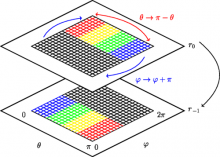
Abstract
Numerical relativity codes that do not make assumptions on spatial symmetries most commonly adopt Cartesian coordinates. While these coordinates have many attractive features, spherical coordinates are much better suited to take advantage of approximate symmetries in a number of astrophysical objects, including single stars, black holes, and accretion disks. While the appearance of coordinate singularities often spoils numerical relativity simulations in spherical coordinates, especially in the absence of any symmetry assumptions, it has recently been demonstrated that these problems can be avoided if the coordinate singularities are handled analytically. This is possible with the help of a reference-metric version of the Baumgarte-Shapiro-Shibata-Nakamura formulation together with a proper rescaling of tensorial quantities. In this paper we report on an implementation of this formalism in the Einstein Toolkit. We adapt the Einstein Toolkit infrastructure, originally designed for Cartesian coordinates, to handle spherical coordinates, by providing appropriate boundary conditions at both inner and outer boundaries. We perform numerical simulations for a disturbed Kerr black hole, extract the gravitational wave signal, and demonstrate that the noise in these signals is orders of magnitude smaller when computed on spherical grids rather than Cartesian grids. With the public release of our new Einstein Toolkit thorns, our methods for numerical relativity in spherical coordinates will become available to the entire numerical relativity community.